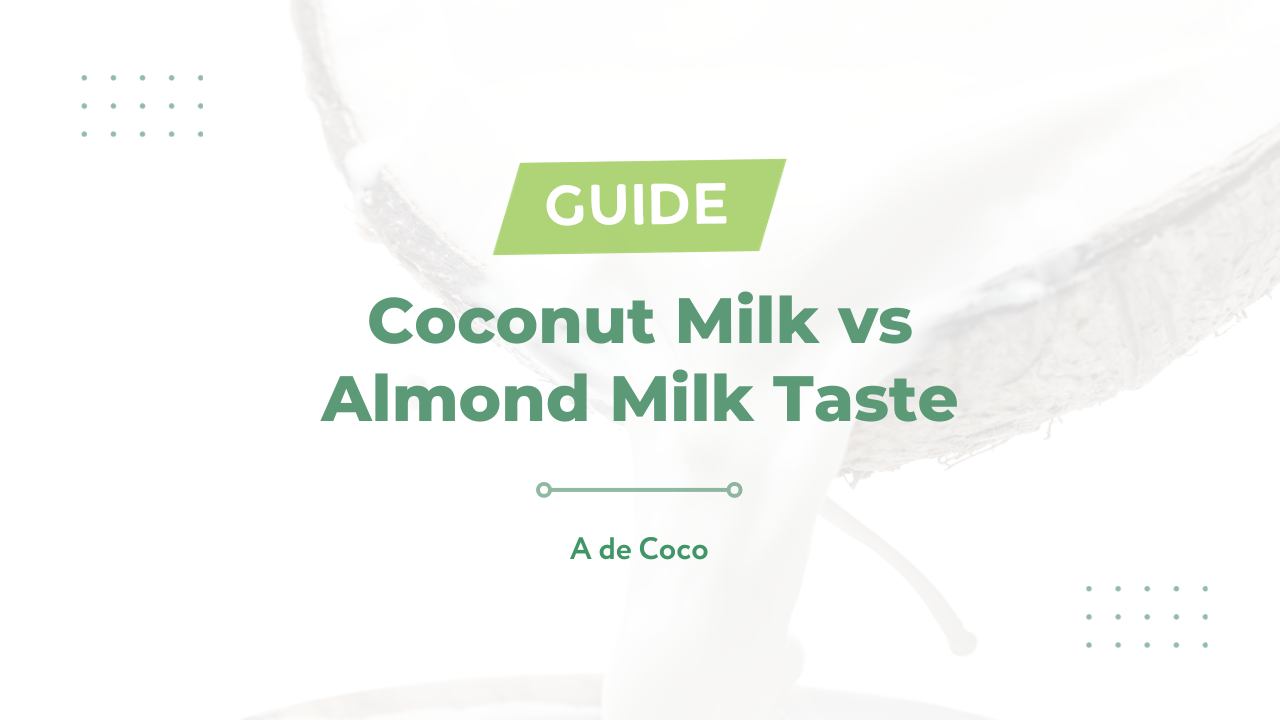In recent years, the demand for plant-based milk alternatives has significantly increased, leading to an array of options gracing grocery store shelves.
Among these, coconut and almond milk are two popular choices attracting both vegans and lactose-intolerant consumers alike.
However, a common question arises concerning their taste.
Indeed, the flavor profile of these non-dairy substitutes is an essential factor for many when selecting their preferred beverage.
Today, we delve into the taste of these two popular milk alternatives and examine if one truly ranks superior to the other.
We aim for this exploration to assist in making your everyday dietary decisions more informed and enjoyable.
Contents
- Coconut Milk Vs Almond Milk Taste: Is One Better Than The Other?
- Understanding the Difference Between Coconut Milk and Almond Milk
- What’s the Basis of Coconut Milk Taste?
- An Insight into the Almond Milk Flavor Profile
- Influence of Texture in Coconut and Almond Milk Flavor
- Dietary Considerations When Choosing
- Sweetening Options for Coconut and Almond Milk
- Experimenting with Both in Different Recipes
- Final Thoughts
Coconut Milk Vs Almond Milk Taste: Is One Better Than The Other?
The taste preference between coconut milk and almond milk heavily relies on individual palate. Coconut milk often has a rich, creamy texture and a sweet, slightly tropical flavor, while almond milk generally has a light, nutty taste. While neither is inherently superior, personal dietary requirements or flavor preferences can make one more favorable than the other.
Additionally, it’s worth noting that the nutritional profile and potential health benefits associated with these two distinct milk alternatives also vary considerably.
Beyond mere taste, we will delve into the myriad of factors that could influence your choice between coconut milk and almond milk.
This includes their individual nutrient contents, potential allergenicity, ecological implications, and utility in different culinary contexts.
Stay tuned to gain a more comprehensive understanding of these commonly consumed plant-based beverages.
Understanding the Difference Between Coconut Milk and Almond Milk
In recent years, plant-based milk substitutes have become increasingly popular due to dietary restrictions, health considerations, and personal preference.
One of the most common dilemmas people face when switching to plant-based milk is choosing between coconut milk and almond milk.
Understanding the essential differences between these two could make a significant difference in your diet and meal preparations.
In this discussion, we’ll delve into the fundamental characteristics that set coconut milk and almond milk apart, in order to help you make an informed choice.
Coconuts versus Almonds
As the names imply, coconut milk and almond milk come from two different sources.
Coconut milk is extracted from the flesh of mature coconuts.
It is rich, creamy, and carries the distinctive flavor of coconuts.
Almond milk, on the other hand, is made from ground almonds and water.
It is lighter, nutty, and subtly sweet; the creation process also varies between the two.
Coconut milk is generally obtained by grating the white flesh, soaking it in warm water, and then sieving out the milk.
This difference in processing methods contributes to their unique taste profiles, textures, and nutritional values.
Nutritional Profiles
Another primary factor differentiating coconut milk and almond milk is their nutritional content.
The type of nutrients and their quantities greatly differ between these two plant-based milk substitutes.
Coconut milk is known for its high saturated fat content.
This aspect makes it highly caloric and often a preferred choice for those who are looking to gain weight or increase their calorie intake.
It’s also rich in many vitamins and minerals, such as vitamin B, vitamin C, and many essential minerals.
On the other hand, almond milk is commonly chosen for its low-calorie content.
It’s a great dairy milk alternative for those who are trying to lose weight or manage their calorie intake.
Almond milk is also a good source of vitamin E and is often fortified with calcium and vitamin D.
Furthermore, almond milk typically contains low amounts of protein, while coconut milk has an average amount.
This highlights once again the importance of understanding your personal nutritional needs when choosing between coconut and almond milk.
Impact on the Environment
Lastly, it’s crucial to acknowledge that both coconut milk and almond milk have different impacts on the environment.
Almond milk production has a higher water footprint as almond trees require a lot of water.
It is also reported to impact bee populations due to the large number of bees required for almond pollination.
On the other hand, coconut milk production has lesser environmental impact due to the relatively low water needs of coconut trees, and it doesn’t have the same level of impact on bee populations.
Yet, the mass production of coconut milk can sometimes result in deforestation and negatively affect biodiversity.
While choosing a plant-based milk may rely primarily on taste preference and nutritional needs, considering the environmental impact is equally important in the long run.
In essence, the choice between coconut milk and almond milk involves several considerations ranging from taste preferences, nutritional needs, dietary restrictions, and environmental impact.
What’s the Basis of Coconut Milk Taste?
The taste of coconut milk can be an intriguing subject for anyone who is not familiar with this dairy alternative.
This milk is obtained from mature coconuts and contains a unique blend of sweet and creamy features.
Naturally Sweet Flavor of Coconut Milk
One of the most prominent features of coconut milk is its naturally sweet flavor.
Credit for this goes to the natural sugar present in coconuts, which imparts a distinctive sweetness.
However, the sweetness is not overwhelming and blends harmoniously with the creamy undertone of coconut milk.
The naturally sweet flavor of coconut milk is due to the presence of sugar in the coconut itself.
This sugar is naturally derived from the coconut fruit, making it a healthier choice than refined sugars.
The sweetness is also present in a moderate level, making it an appropriate choice for individuals who are trying to control their sugar intake.
The Creamy Undertone of Coconut Milk
Another characteristic flavor profile of coconut milk is the creamy undertone.
This is due to the high content of coconut oil, which contributes to a rich and creamy consistency.
The high oil content makes coconut milk an ideal choice for recipes requiring a luscious texture without dairy.
The richness from the high coconut oil content creates a rich and creamy consistency, making coconut milk a preferred choice for creamy dairy-free recipes.
The creamy consistency of coconut milk often overpowers the subtle sweetness and lends a creamy finish to the milk.
This may also give the coconut milk a slightly heavier feeling compared to other non-dairy alternatives.
Mild Coconut Flavor
The third significant characteristic of coconut milk’s taste is the mild coconut flavor.
This flavor is distinguishable but not overpowering, subtly reminding of its origin without making it the star feature of the milk.
This subtle flavor is what sets coconut milk apart from other dairy-free alternatives, as it imparts a tropical hint to whatever dish it is used in.
Coconut milk carries a distinguishable but subtle coconut flavor, offering a tropical twist in the dishes it is used.
This flavor works exceptionally well in sweet dishes, desserts, tropical cocktails, and even savory cuisines.
The taste of coconut milk is a blend of three main flavors: natural sweetness, creamy undertone, and subtle coconut flavor.
An Insight into the Almond Milk Flavor Profile
Almond milk’s flavor is significantly different from regular dairy milk and other plant-based alternatives, including coconut milk.
It possesses a slightly nutty and sweet taste, which aligns with the flavor profile of almonds themselves.
Genuine Almond Taste
When we speak of the genuine almond taste, what we’re referring to is an underpinning nuttiness that’s subtly sweet and creamy.
This is one of the key elements that contributes towards the overall flavor profile of almond milk.
The essence of almonds is captured perfectly across a spectrum of almond milk options, both sweetened and unsweetened.
Variations in Almond Milk
Flavored variations of almond milk are also commercially available, with entries such as chocolate and vanilla almond milk being popular choices.
This natural flavor versatility gives almond milk wide applicability in various dishes and drinks, from teas and coffees to savory sauces and desserts.
Albeit a strong factor, taste isn’t the only aspect to consider when evaluating almond milk – texture plays a significant role as well.
Many consumers prefer almond milk not only for its delicate flavor but also its texture, which often mirrors that of dairy milk closely.
The Impact of Sweetness
Naturally, the sweetness level is also a major player in the flavor profile of almond milk.
This sweetness may come from the almonds themselves or added sugars in commercially produced versions.
That being said, it is always advisable to be vigilant of the sugar content when choosing almond milk, as this could heavily alter the expected flavor profile.
Influence of Texture in Coconut and Almond Milk Flavor
The Texture of Coconut Milk
When considering the texture of coconut milk, it’s significant to point out that it has a thick, creamy and rich consistency.
Because of this, it often envelops your entire palate, providing a full-bodied experience that can strongly influence the perceived flavor.
This thick and creamy texture can make the coconut milk seem darker and more intense in flavor, and this perception can vary greatly based on the type of coconut milk you’re consuming – whether it’s from a can, fresh, or a watered-down version designed for drinking.
This thick and creamy texture can make the coconut milk seem darker and more intense in flavor, and this perception can vary greatly based on the type of coconut milk you’re consuming – whether it’s from a can, fresh, or a watered-down version designed for drinking.
Understanding the influence of texture on flavor helps us understand why coconut milk is often associated with sumptuous, hearty dishes.
It’s able to stand up to strong flavors and still maintain its own, even in something as potent as a Thai curry or a spicy soup.
The Texture of Almond Milk
On the other hand, almond milk has a completely different texture.
Its texture is often described as light and somewhat watery with a slight creaminess, far from the full-bodied experience of coconut milk.
The texture of almond milk has a much subtler influence on its flavor.
The texture of almond milk has a much subtler influence on its flavor.
Because almond milk lacks the creaminess and thickness of coconut milk, its flavor is often described as subtle, sweet, and nutty.
Even though it doesn’t have the same full-bodied take-over-the-palate experience of coconut milk, the light and soft texture of almond milk makes it versatile in a different way.
Texture and Cookery
The influence of texture on the flavor perception also comes into play when using either of these milks in cooking.
Coconut milk, with its creamy texture, is often used in curries, soups, and baking for its ability to infuse rich, luxurious flavor.
It’s worth noting that some flavors naturally pair well with a creamier texture which could limit coconut milk’s use in certain dishes.
Contrariwise, almond milk’s light texture makes it an adaptable choice for baking as well as a dairy substitute in light sauces, smoothies and more.
Contrariwise, almond milk’s light texture makes it an adaptable choice for baking as well as a dairy substitute in light sauces, smoothies and more.
Its lightness doesn’t overpower the dish or drink, allowing the other flavors to shine.
However, its subtle almond flavor is sometimes not suitable for recipes that don’t complement a nutty taste.
Both coconut and almond milk offer unique textures that tangibly influence their flavor profiles.
Certain dishes will call for a thick, lavish texture, whereas others need the light, slight creaminess provided by almond milk.
The role of texture in flavor perception and cooking application is an important consideration in using these dairy alternatives.
Dietary Considerations When Choosing
When it comes to choosing between coconut milk and almond milk, various dietary considerations can significantly influence your decision.
Firstly, it’s crucial to comprehend the nutritional disparity between the two.
Nutritional Facts of Almond and Coconut Milk
Almond Milk tends to be significantly lower in calories and fat as compared to Coconut Milk.
For people who are striving for calorie control or weight loss, almond milk may be an excellent choice.
On the other hand, Coconut Milk is rich in saturated fats, which are capable of raising cholesterol levels.
However, it’s composed of medium-chain triglycerides (MCTs), a type of fat that your body can absorb and use quickly.
This quality can make it a suitable choice for athletes or those needing a quick energy surge.
Nutritional needs can greatly determine whether almond milk or coconut milk is a better fit for you.
Aiding the above quote, it comes down to knowing your unique nutritional requirements and selecting a milk alternative that supports your health or dietary goals.
Both options are gluten-free, soy free, and lactose-free.
So, if you have allergies or sensitivities to these food components, both almond milk and coconut milk could be sound alternatives.
Vitamin and Minerals Content
Almond milk tends to be higher in Vitamin E, a potent antioxidant, while coconut milk beats almond milk in terms of iron and potassium content.
Therefore, your need for these minerals and vitamins can be a deciding factor.
Note that many almond and coconut milk varieties available in the market are fortified with extra nutrients, such as Vitamin B12, Vitamin D, and calcium, making them even more nutritious.
Dietary Restrictions and Preferences
Just aside from allergies, other dietary preferences or restrictions may push you towards one or the other.
For instance, those following a low-carb or keto diet might prefer coconut milk due to its high-fat content.
Meanwhile, vegans or those with dairy intolerance can enjoy both coconut and almond milk as they’re plant-based alternatives.
Meanwhile, those who don’t like the thicker consistency or slight coconut taste of full-fat coconut milk might prefer the lighter flavor of almond milk.
Personal preference and the specific use of the milk in recipes or beverages can be final deciding factors.
Your personal preference for taste and consistency, along with your dietary restrictions or needs, can help decide whether almond or coconut milk is the right choice for you.
To further support the reasoning in the above quotation, consider your flavor preferences, dietary needs, and how you plan to use the milk before finalizing your choice.
Sweetening Options for Coconut and Almond Milk
Unsweetened vs Sweetened Milk Varieties
Before delving into the specifics of sweetening options, it’s important to understand that both coconut and almond milk come in sweetened and unsweetened varieties.
The sweetened versions typically contain added sugars which change not only the nutritional profile, but also the flavor and consistency of the milks.
On the contrary, unsweetened variants are a healthier choice since they contain no added sugars, bearing a more natural and subtle taste.
By keeping in mind your health preferences, and purpose of use, you can make an informed choice between sweetened and unsweetened milks.
For instance, if you are following a low-carb or sugar-free diet, the unsweetened variant would be the best pick.
Similarly, for those who prefer their milk to have a hint of sweetness, or are using it for a dessert recipe, sweetened milk can be more appropriate.
Incorporating Natural Sweeteners
Another way to customize the sweetness level of your coconut or almond milk is by incorporating natural sweeteners.
Natural sweeteners like honey, maple syrup, and agave nectar can be added as per taste, allowing a more hands-on control over the sweetness.
These sweeteners not only elevate the flavor but also offer their unique health benefits, making your milk more nutritious.
Natural sweeteners with their nutritional perks serve as an excellent option to control the sweetness level without compromising the health quotient.
Honey, for example, has potent antimicrobial and antioxidant qualities, while maple syrup is a good source of magnesium, potassium, and zinc.
Agave nectar is famed for its low glycemic index, making it a suitable sweetener for diabetics.
Benefit of Artificial Sweeteners
Although natural sweeteners are a healthier option, there’s also a place for artificial sweeteners in the sweetening world of coconut and almond milks.
If you’re looking to maintain a low-calorie diet, you might opt for artificial sweeteners like stevia, sucralose (Splenda), or aspartame.
The immense sweetness of these substitutes allows you to use less of them, thereby limiting your caloric intake.
However, it’s worth noting that artificial sweeteners, although calorie-free, can have a different aftertaste and may impact the overall flavor of your milk.
Artificial sweeteners are a feasible alternative for those on a low-calorie diet, but one must remain cognizant of the altered taste.
Ultimately, whether you opt for natural or artificial sweeteners, the choice will depend on your personal preferences and dietary restrictions.
From choosing between sweetened and unsweetened variants, adding natural sweeteners or incorporating artificial ones, there exists a multitude of options to sweeten your coconut or almond milk exactly the way you like it.
Experimenting with Both in Different Recipes
One of the critical areas of interest lies in the application of coconut milk and almond milk in various recipes.
Using Coconut Milk in Recipes
The high-fat content in coconut milk suits savory dishes such as curry very well.
This is because coconut milk has the ability to tone down the spiciness of dishes due to its creamy, rich texture.
Interestingly, it is also widely used in desserts like custards and ice creams imparting a distinct sweet tropical flavor to the dishes.
Coconut milk is a versatile ingredient, and its inherent sweetness can be utilized in baking and confectionery.
Interestingly, it is also widely used in desserts like custards and ice creams imparting a distinct sweet tropical flavor to the dishes.
This versatility is backed up by the fact that the milk brings a unique velvety texture to the dishes while also adding to their nutritional value.
Using Almond Milk in Recipes
Almond milk, on the other hand, has a more nutty and less sweet taste, making it perfect for breakfast dishes like smoothies, cereals, and muesli.
It’s creamy consistency allows it to be used as a dairy milk substitute in coffee and tea.
Furthermore, it blends very well in soups, sauces, and baking recipes where it contributes a mild nutty flavor without overwhelming the dish.
Interestingly, almond milk can be used to make vegan cheeses, thanks to its consistency and taste.
Furthermore, it blends very well in soups, sauces, and baking recipes where it contributes a mild nutty flavor without overwhelming the dish.
Such wide-ranging applications make almond milk a staple in any kitchen, especially for those following a plant-based or vegan diet.
Another key exploration involves the nutritive components that these milks carry.
Coconut milk, due to its high fat content, imparts a far greater level of richness and creaminess to dishes compared to almond milk.
However, almond milk is often favored for its lower calorie content and its higher level of certain essential nutrients like Calcium and Vitamin E, ensuring that heath-freaks have a great option to resort to.
Final Thoughts
Overall, both coconut milk and almond milk offer unique taste profiles, dietary benefits, and versatility in recipes, making them suitable non-dairy alternatives.
Coconut milk, with its tropical taste and creamy texture, provides significant health advantages such as boosting the immune system and hydrating the body.
On the other hand, almond milk’s subtly sweet, nutty flavor and nutritional benefits, like being low in calories and high in vitamins, make it an ideal choice for health-conscious consumers.
Choosing between the two largely depends on individual dietary needs, taste preferences, and any specific recipe requirements.
Additionally, the use of different sweetening options can further enhance the flavors of these non-dairy milks.
Understanding their unique characteristics can assist consumers in making an informed decision that aligns with their lifestyle, palate, and health goals.




